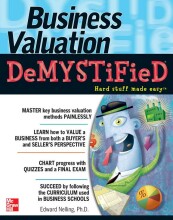Summary: Business Valuation Demystified | 9780071759489 | Edward Nelling
- This + 400k other summaries
- A unique study and practice tool
- Never study anything twice again
- Get the grades you hope for
- 100% sure, 100% understanding
Read the summary and the most important questions on Business Valuation Demystified | 9780071759489 | Edward Nelling
-
1 Commonly Used Valuation Methods
This is a preview. There are 1 more flashcards available for chapter 1
Show more cards here -
What are three common valuation methods?
- DCF valuation method
- Price multiple valuation method
- Liquidation valuation method
- DCF valuation method
-
What does the valuation method DCF calculate?
The worth of a business as the present value of the future economic benefits (cash flows) generated by the business. -
What is the calculation of the DCF method?
Divide the future cash flows by the 1+discount rate and add up the terminal value in the end divided by 1+discount rate. -
What kind of assumption do we take when using the price multiple valuation method?
That 2 or more companies that are in the same line of business should receive the same valuations in the marketplace. -
What is the calculation of the value via the price multiple valuation method?
net income x price/earnings multiple
For example:- The net income is $60,000
- The typical business sells for 10 times its expected earnings (price/earnings multiple = 10)
$60,000 x 10 = $600,000
The calculation of the price/earnings multiple:
(value/expected earnings) + (value/expected earnings)
----------------------------------------------------------------------------------------
2 -
What is the opposite of liquadation and what does it mean?
The opposite is 'going concern' and it means it is expected to continue. -
Which valuation method would give the 'worst case scenario' in terms of valuation? What is another word for this method?
The liquidation valuation method would give you the worst case scenario. Another word for this approach is the 'fire sale approach'. -
Which valuation method would give you the best insight into how your business is doing in comparison to others in the same industry?
The price multiple valuation method. -
2 An Overview of Financial Statements
This is a preview. There are 19 more flashcards available for chapter 2
Show more cards here -
What are assets on the balance sheet? And what is the difference between current and fixed?
Resources that are expected to generate future economic benefits.- A current asset is an asset that is expected to be liquidated within 1 year/operating cycle (cash, accounts receivable, inventory).
- A fixed asset is an asset that will provide long-term economic benefits (property, plant, equipment).
-
What are liabilities on the balance sheet? And what is the difference between current and non-current?
Obligations that will lead to an outflow of economic benefits.- A current liability is an obligation that is expected to be fulfilled within 1 year/operating cycle (accounts payable, short-term debt, long-term debt due next year).
- A non-current liability is all other liabilities (long-term debt).
- Higher grades + faster learning
- Never study anything twice
- 100% sure, 100% understanding































